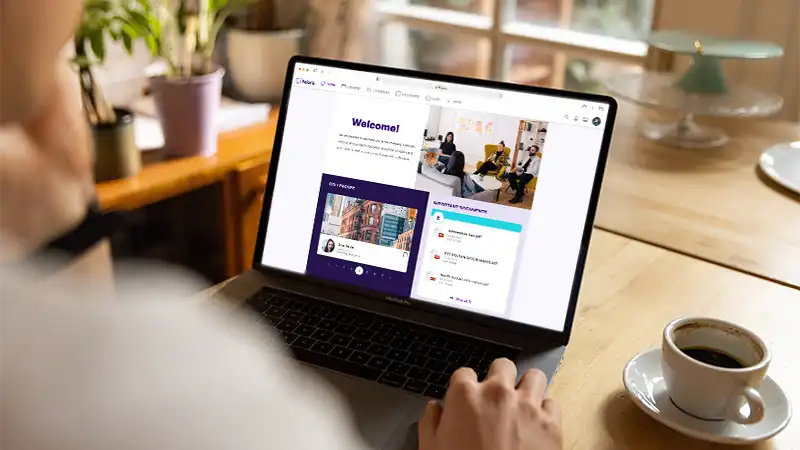Internal communication channels are the backbone of every successful company. Effective internal communication not only ensures that day-to-day business runs smoothly, but also promotes employee loyalty and motivation. The boundaries between personal and digital interactions are becoming increasingly blurred. It is therefore crucial that companies choose the right communication channels to reach their teams efficiently and effectively.
In this blog post, we take a closer look at the various internal communication tools available, from traditional methods such as emails and employee magazines to modern solutions such as social intranets and comprehensive employee apps. We analyse their advantages and disadvantages and evaluate how they can best be used in different corporate contexts to ensure strong internal communication.
From New Work to New Communication: Internal communication channels in transition
The concepts of New Work and advancing digitalisation have profoundly changed internal communication in companies. They shape the way information flows and employees interact. New Work, which emphasises flexibility, autonomy and a better work-life balance, challenges traditional rigid communication structures and makes way for more dynamic, digital solutions.
Digital platforms enable teams to communicate and collaborate efficiently regardless of geographical boundaries. These tools support a variety of working styles and environments, from remote working to globally distributed teams, and help to ensure that information is distributed quickly and transparently. Internal communication channels allow employee feedback to be obtained in real time and adjustments to be made quickly, which is particularly beneficial in fast-moving industries. By offering seamless integration of different communication channels – from instant messaging and video conferencing to comprehensive employee apps – digital technologies play a crucial role in shaping an open and connected corporate culture that ideally complements New Work.
Digitalisation not only leads to more efficient and effective communication, but also to greater employee loyalty and satisfaction through increased participation in the company’s activities.
Requirements for internal communication channels
When selecting a channel for internal communication, companies need to consider several key factors to ensure that it meets the specific needs of the organisation.
Ease of use
Firstly, user-friendliness is crucial. An intuitive design ensures that employees of all technical skill levels can use the platform easily, leading to greater acceptance and more regular use. Easy navigation, clear instructions and accessibility on different devices such as smartphones, tablets and desktop computers are essential to reach a broad user base.
Two-way communication
Two-way communication, i.e. top-down and bottom-up communication, promotes an open communication climate in which employees feel encouraged to give feedback and take part in discussions. Channels that support interactions such as comments, surveys and forums help to ensure that employees’ voices are heard and their contributions are recognised. This type of interactive communication also helps managers to respond better to the needs and concerns of the workforce and strengthen employee loyalty. To do this effectively, systems must be designed to be easily accessible and intuitive to encourage active participation by all employees.
Information in real time
An effective channel should also offer the possibility of disseminating information quickly and in real time in order to be able to react to the dynamics of modern business processes. Communication channels must be designed in such a way that news and updates are distributed to all relevant people without noticeable delays. This requires the systems to have high availability and low downtimes in order to ensure continuous communication.
Platform concept
Modern approaches utilise the platform concept. This approach integrates various forms of communication and tools in an environment that is coherent and clear. It not only improves the distribution of information, but also promotes interaction and collaboration between employees. Such platforms can offer advanced features, such as personalised dashboards, access to company policies, shift and canteen schedules, which facilitate daily work and increase efficiency.
Privacy & Security
Data protection and security are also a top priority, especially when transmitting sensitive or confidential information. It is essential that the platforms used implement robust security measures to ensure the confidentiality and integrity of the information transmitted. This includes encryption technologies for data transmission and storage, regular security audits and compliance with data protection standards such as the GDPR.
Taken together, these requirements for internal communication channels create a robust foundation for a communication strategy that not only improves information distribution, but also fosters a collaborative and engaged corporate culture.
Overview of internal communication channels
Deeper understanding through face-to-face dialogue: The personal conversation
Despite the many digital means of communication, face-to-face dialogue remains an invaluable channel for exchanging ideas and feelings. It enables an immediate, empathetic connection, which is often crucial for clarifying misunderstandings and reaching profound agreements. Face-to-face discussions promote trust and team spirit and are particularly important in situations where sensitive or critical issues need to be discussed.
Email communication: Effective or flooded with information?
Email remains a fundamental communication channel for companies. It is ideal for sending formal messages and recording information. However, it can quickly lead to information overload and is not suitable for urgent communication.
(Social) intranet: the problem of topicality
Traditional intranets serve as a central point of contact for information and resources and are particularly useful for accessing documents and company guidelines. Social intranets extend this functionality with interactive features such as discussion forums, blogs and social networks that promote employee participation and knowledge sharing. These platforms are effective in building a strong corporate culture and improving the flow of information, but cannot replace direct communication. One of the main problems is the topicality of the content. Information is often outdated because the update process is cumbersome or not carried out regularly, which affects the relevance and reliability of the data provided.
Notice board and employee magazine: outdated channels?
While the notice board is a classic approach to reaching employees on site, the employee magazine offers more in-depth insights and strengthens the corporate culture through more detailed articles and reports. However, both are less suitable for fast or interactive communication and are supplemented by digital alternatives in many companies.
Security risks with instant messaging and chat apps
These tools provide a platform for quick and informal discussions. They are ideal for enabling team collaboration in real time and promoting rapid feedback. The main disadvantage is that important information can get lost in the flow of fast communication. Security concerns also pose a significant challenge. Many instant messaging platforms may not be adequately secured, making them vulnerable to data breaches. Companies must ensure that all communication apps used comply with the applicable data protection regulations and that sensitive information is transmitted securely.
The efficiency trap: meetings and conferences (telephone, video)
Meetings, whether physical, by phone or video, are essential for detailed discussions and decision-making. They enable direct feedback and promote a deeper understanding of complex topics. While physical meetings offer maximum personal interaction, telephone and video conferences allow flexibility and accessibility across geographical boundaries. However, technical problems and the need for tight organisation can present challenges. Another problem is meeting efficiency. Meetings are often held without a clear agenda or objective, which leads to unnecessary delays and reduced decision-making. The need for tight organisation and planning is also a critical point. Effective meetings require precise scheduling, clear role assignments and the right balance between speaking and active participation. Without these structural preparations, meetings can become time-consuming events that do little to solve problems or promote projects.
Reach everyone anytime, anywhere: Employee apps
As a hybrid solution, employee apps combine the advantages of mobile and desktop access, which ensures broad accessibility. They not only enable communication and information exchange in real time, but also support the integration of different business functions and systems. Equipped with comprehensive safety measures, they offer a robust platform for the modern workplace.
Employee app and internal communication channels in comparison
When choosing the right communication channels, companies need to consider a variety of requirements to ensure that the tools effectively and efficiently meet the specific needs of the organisation. Here we compare common communication channels on the basis of the requirements already discussed.
The personal dialogue
Ease of use
Face-to-face dialogue offers a direct and immediate form of communication that is often perceived as more natural and personal. It requires no technical knowledge or special equipment and is therefore accessible to all employees.
Two-way communication
Employees can freely share their thoughts, concerns and ideas in face-to-face meetings and receive immediate feedback. This promotes an open and transparent communication culture and strengthens employee loyalty.
Information in real time
Face-to-face dialogue enables information to be communicated immediately and is particularly effective for urgent or sensitive issues that require immediate attention.
Platform concept
Face-to-face dialogue is not tied to a specific platform and allows employees to engage personally and build relationships, which is crucial for company culture and teamwork.
Privacy & Security
As face-to-face meetings usually take place offline, there are fewer concerns about data protection and security. Nevertheless, confidential information must be handled and protected appropriately in order to avoid misuse.
Ease of use
E-mails are widespread and intuitive to use, making them a basic means of communication. They are accessible on various devices and offer a structured form of communication.
Two-way communication
Emails support both top-down and bottom-up communication. However, they are less interactive and do not offer direct feedback mechanisms such as comments or surveys.
Information in real time
Whilst emails can be sent promptly, there is a risk that important messages get lost in a flood of emails and are not seen immediately.
Platform concept
E-mails integrate into many company systems, but they do not offer the comprehensive functionality of a modern communication hub.
Privacy & Security
Emails can be encrypted, but they are also vulnerable to phishing attacks and other security risks. Organisations need to ensure that their email systems are robustly secured.
Intranet
Ease of use
Intranets offer a central point of contact that should be easy to navigate. However, outdated or poorly designed user interfaces can make it difficult to use. In addition, intranets are usually only available as web and desktop versions, which limits their use for employees working on mobile devices.
Two-way communication
Traditional intranets often only support limited interactive functions, which restricts employee participation and feedback.
Information in real time
Information can be centralised and updated quickly, but its use depends heavily on user acceptance.
Platform concept
Intranets integrate various resources and tools, which promotes coherence and clarity. Advanced features such as personalised dashboards and access to company policies are often included.
Privacy & Security
Well-secured intranets can offer a high level of data protection, but regular updates and security audits must be carried out.
Social Intranet
Ease of use
Social intranets offer additional interactive functions such as forums, blogs and social networks that should be easy to navigate. They encourage active use by employees. Like traditional intranets, social intranets are usually only available as web and desktop versions, which limits their use for mobile employees.
Two-way communication
These platforms encourage interaction and feedback through functions such as comments, surveys and forums, which strengthens employee participation.
Information in real time
Information can be disseminated quickly and efficiently. The interactive nature also promotes the exchange of knowledge and collaboration.
Platform concept
Social intranets integrate various forms of communication and tools in a coherent environment that not only promotes the distribution of information, but also interaction and collaboration between employees.
Privacy & Security
As with traditional intranets, social intranets also rely on robust security measures to ensure the confidentiality and integrity of information. Regular security audits and compliance with data protection standards are required.
Instant messaging and chat apps
Ease of use
These tools are intuitive and promote rapid communication. They are easily accessible on various devices.
Two-way communication
Instant messaging and chat apps enable immediate feedback and promote informal interaction.
Information in real time
Messages are transmitted in real time, but there is a risk of information overload and the loss of important information in the message flow.
Platform concept
These apps can be integrated into larger platforms to enable seamless communication.
Privacy & Security
Security functions such as end-to-end encryption are crucial to ensure the confidentiality of communication.
Employee apps
Ease of use
Employee apps need to be intuitively designed and accessible on a variety of devices, including smartphones, tablets and desktop computers. This comprehensive accessibility promotes a high level of acceptance and regular use by employees.
Two-way communication
These apps encourage interaction and feedback through functions such as surveys and forums, which strengthens employee participation.
Information in real time
Information can be disseminated in real time, making it particularly useful in dynamic environments.
Platform concept
Employee apps integrate various communication and business functions into a single platform, improving efficiency and consistency.
Privacy & Security
Robust security measures, including encryption and regular security audits, are required to ensure the confidentiality of information.
Notice board and employee magazine
Ease of use
These traditional methods are easy to understand, but not always easily accessible, especially for remote workers.
Two-way communication
These channels offer limited interactivity and feedback opportunities, which can limit employee participation.
Information in real time
Updates are often delayed, which can affect the relevance of the information.
Platform concept
These methods are static and do not offer integrated functions that are available in modern digital platforms.
Privacy & Security
Security risks are lower, but access to sensitive information can be more difficult to control.
Measuring internal communication: the importance and methods of evaluating effectiveness
Internal communication forms the backbone of every company by informing and motivating employees and involving them in the company’s goals. But how can you ensure that these communication strategies are actually effective? Measuring internal communication is critical to evaluating the success of strategies, identifying opportunities for improvement and fostering a positive work environment.
Why is the measurement of internal communication important?
Internal communication is not only a means of conveying information, but also an essential component of corporate culture and employee engagement. Effective communication can increase productivity, strengthen employee loyalty and ultimately support the company’s success. By measuring internal communication, companies can:
-
Identify performance improvements
By measuring the success of their communication strategies, companies can recognise what is working and what is not. On this basis, they can make adjustments to improve effectiveness and achieve the desired results.
-
Promoting employee commitment
Clear and transparent communication helps to strengthen employees' trust and increase their satisfaction in the workplace. By measuring communication, companies can better understand the needs and concerns of their employees and respond to them in a targeted manner.
-
Aligning corporate goals
Companies and event organizers that are committed to sustainability improve their image and reputation with customers, partners and the public.
Methods for measuring internal communication
There are various methods and tools for measuring the effectiveness of internal communication. Some of the most common approaches are:
-
Employee surveys
Regular surveys can provide insights into the opinions and needs of employees and assess satisfaction with internal communication.
-
Feedback mechanisms
Setting up feedback channels such as suggestion boxes, regular feedback meetings or an open door policy enables employees to share their thoughts and ideas and make suggestions for improvement.
-
Measurement of key communication figures
Analysing key figures such as email open rates, participation rates at events or usage rates of communication platforms can provide information about the effectiveness of certain means of communication.
-
Qualitative analyses
Through interviews, focus groups or qualitative content analyses, companies can gain a deeper understanding of how employees perceive and interpret internal communication.
Conclusion and outlook
The integration of digital platforms and tools as internal communication channels that enable seamless communication and collaboration is becoming increasingly important. Not only technical aspects play a role here, but also the promotion of an open and networked corporate culture.
Measuring the effectiveness of internal communication strategies will also become increasingly important. Through regular evaluations and feedback mechanisms, companies can ensure that their communication measures are having the desired effect and make adjustments if necessary.
Forward-looking companies should focus on the following key aspects:
-
Continuous improvement
Continuous evaluation and optimisation of communication channels and strategies based on employee feedback and key figures.
-
Technological integration
Utilisation of modern technologies to simplify communication processes and increase efficiency.
-
Cultural promotion
Establishing a communication culture that promotes openness, transparency and employee participation.
-
Flexibility and adaptability
Ability to react quickly to changes in the working environment and implement appropriate communication solutions.
By considering these factors, organisations can not only improve their internal communications, but also build a stronger, more engaged and satisfied workforce that is better prepared for the challenges and opportunities of the modern workplace.








